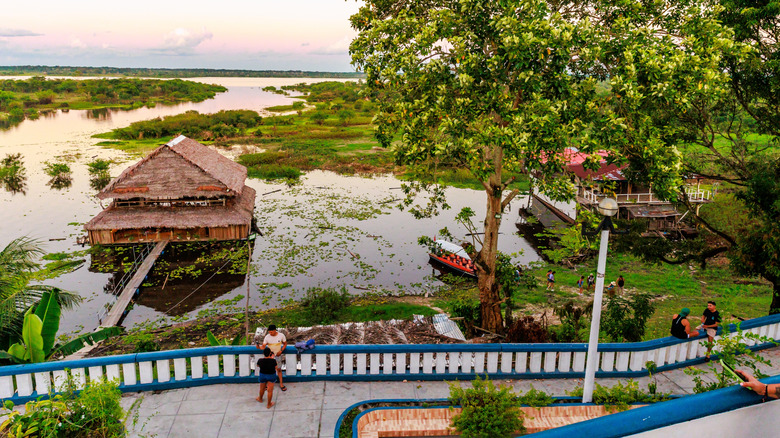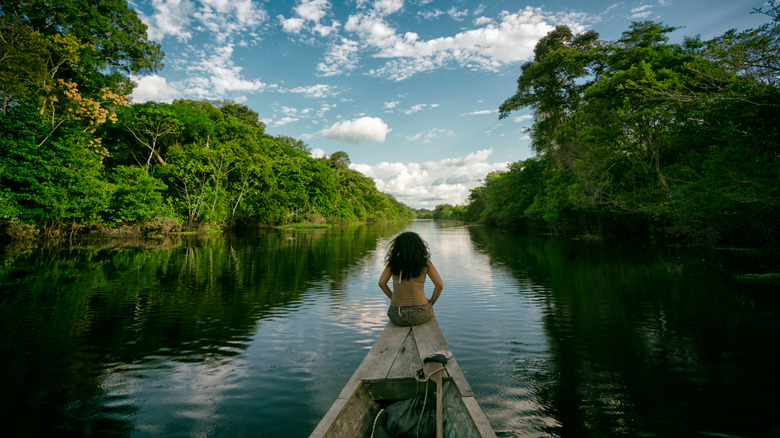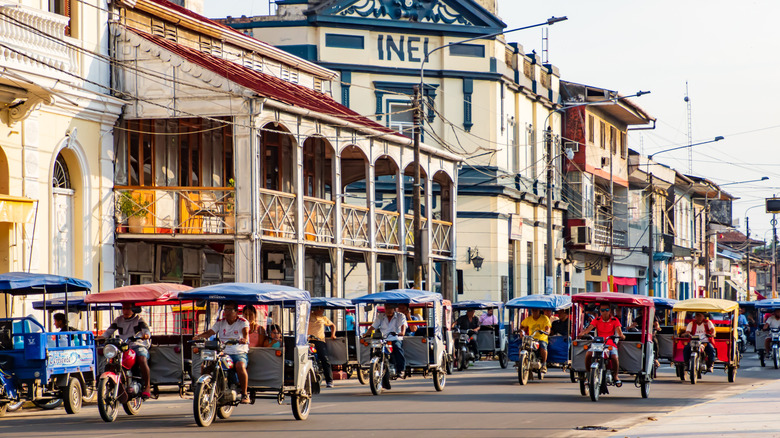The World's Largest City Inaccessible By Land Is A Vibrant Gateway To The Amazon River
The Amazon River slinks through the northern jungles of Peru, rushing past the remotest corners of the earth alongside uncontacted tribes and rare wild animals. It continues up to Colombia's tiniest outposts, flowing onwards through the breadth of giant Brazil. It's the widest river in the world, the lifeblood of the earth's most biodiverse region. Stemming from the heaving "lungs of our planet," there is a small city that sits at the confluence of the Amazon and the Nanay River. Iquitos, a remote outpost encased by thick jungle foliage, is entirely inaccessible by vehicle-ready road. The only outsiders who have ever set eyes on the city have had to fly in, strap up a hammock on the cargo ships that traverse the Amazon from end to end, or face the thickets with machete in hand.
The easiest way to get to Iquitos is by flight. Planes leave daily from Jorge Chavez International Airport in Lima to the small airport on the city's outskirts. Motorized tuk-tuks linger outside, waiting for landings, ready to take travelers straight to their hotel in town. However, there is a more adventurous way to access the remote metropolis. Catching a cargo boat through the Amazon is an incomparable experience for any traveler with extra time, the best way to watch the biomes shift over the five-day voyage from Pucallpa. There is also a shorter ferry journey from Leticia, Colombia, which takes less than a day.
Explore the wild Amazonian interior from Iquitos
Most visitors to the forest-ensconced port city come to Iquitos for one reason. This is a gateway to the Amazon. Gigantic, mysterious, and utterly wild, the city is surrounded on all sides by one of the most enticing biomes on earth. Travelers and tour guides make a beeline for the Pacaya Samiria National Reserve, Peru's second-largest protected natural area. Home to more than 1,000 animal species and nearly as many plant species, the 8,000 square miles of carefully conserved wetland and rainforest grants many travelers their first glimpse of this extraordinary region.
Multi-day tours can be arranged with an agency in Iquitos, which include the dug-out motorboat transportation and open-air hammock campsite in the deal. Ensure you stick by your guide and keep in mind the 11 things you should never do in the rainforest; do note that guides are mandatory, and the reserve is not accessible to any unescorted travelers.
Tours are largely led by Indigenous guides, who are experts in spotting wildlife that the jungle hides from our untrained eyes. Listen out for calls to peer up at leaping monkeys, to look boatside for the fins of peaking pink dolphins, or to keep your hands to yourself as the giant caimans glide by. If a few days roughing it in the hammock camps and jungle lodges doesn't sound too appealing, you can also opt to book with several cruise ships that depart from Iquitos. Determine your travel style to choose the best Amazon river cruise.
Explore a former trading capital on the banks of the Amazon River
A deluge of tuk-tuks swarm down the wide streets of Iquitos, past the relics of the city's forgotten colonial wealth and the Amazonian promenade. In the peak era of Amazon exploitation, in the late 19th and early 20th century, the rubber forests of Peru were hailed as a new El Dorado. Companies like the Peruvian Amazon Company amassed their wealth on the backs of enslaved Amazonians, built the colonial structures still lingering in Iquitos, and left for more profitable pastures. Stroll past the Plaza de Armas or along the grand Malecon to spy the bones of abandoned grandeur they discarded.
Many travelers go on to visit Belén, a wooden stilt-top neighborhood that hides one of the shadier sides of the city. Don't follow the crowds to Belén without a guide; the novel temptation of its hectic local market isn't worth it. Through the dense haze of flitting mosquitos, it's possible to spy bottled ayahuasca, the severed heads of endangered animal species, and live creatures sold to torment with macabre demonstrations underway.
Though there are many accommodation options in town, many travelers prefer to stay outside the city center, lulled by the jungle sounds at night. Various unique rainforest lodges operate close to the city, including the Amazon's only all-inclusive treehouse lodge, which lets you sleep high in a gorgeous jungle canopy.


